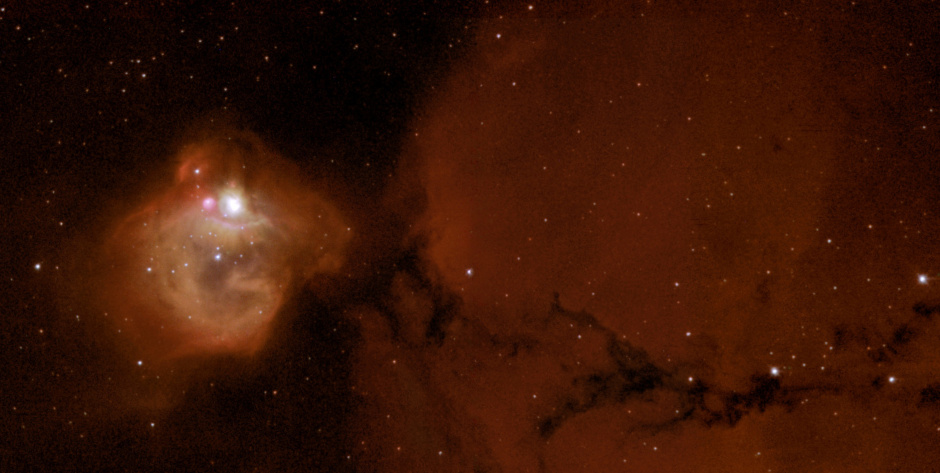NGC 1748로도 알려져 있는 N83B 성운에서 새로 탄생한 밝은 별들로부터 쏟아져 나오는 강력한 복사선들이 둥그런 거품을 만들어내고 있다.
허블 우주 망원경이 촬영한 이 사진은 우리 근처에 존재하는 은하의 새로운 별들이 생성되는 지역에서 발생한 복사선과 은하의 가스들간의 복잡한 상호작용을 판별할 수 있도록 도와주고 있다.
이 사진은 거대한 질량의 별들이 강력한 폭풍을 만들어 주위환경을 침식함으로써, 자신이 태어난 가스가 풍부한 성운의 형태를 어떻게 바꾸고 있는지를 도식적으로 보여주고 있다.
이와 비슷한 작용들이 우리 은하에서는 오리온 성운에서 목격된다.
허블 우주 망원경은 아주 멀리 떨어진 은하들에서 새로운 별들의 탄생과 관련된 지식을 향상시키는데 공헌한 것으로 유명하다.
비록 우주에 존재하는 대부분의 별들이 우주가 어렸던 시절인 수십억년 이전에 탄생했지만, 별들의 형성은 오늘날에도 계속되고 있다.
허블의 이 사진은 우리 이웃 은하중 하나인 대마젤란 성운의 새로운 별이 생성되는 작은 부분을 아주 완전하게 보여주고 있다.
이 은하는 우리 은하로부터 단지 16만 5천 광년밖에 떨어져 있지않으며 남반구에서는 육안으로도 쉽게 볼 수 있다.
출처 : The European Homepage for The NASA/ESA Hubble Space Telescope
http://www.spacetelescope.org/images/html/heic0104a.html
참고 : NGC 1748을 비롯한 각종 성운에 대한 포스팅은 아래 링크를 통해 조회할 수 있습니다.
https://big-crunch.tistory.com/12346974
참고 : 대마젤란 은하를 비롯한 각종 은하 및 은하단에 대한 포스팅은 아래 링크를 통해 확인할 수 있습니다.
- 은하 일반 : https://big-crunch.tistory.com/12346976
- 은하단 및 은하그룹 : https://big-crunch.tistory.com/12346978
- 은하 충돌 : https://big-crunch.tistory.com/12346977
원문>
Extremely intense radiation from newly born, ultra-bright stars has blown a glowing spherical bubble in the nebula N83B, also known as NGC 1748. A new NASA/ESA Hubble Space Telescope image has helped to decipher the complex interplay of gas and radiation of a star-forming region in a nearby galaxy. The image graphically illustrates just how these massive stars sculpt their environment by generating powerful winds that alter the shape of the parent gaseous nebula. These processes are also seen in our Milky Way in regions like the Orion Nebula.
The Hubble telescope is famous for its contribution to our knowledge about star formation in very distant galaxies. Although most of the stars in the Universe were born several billions of years ago, when the Universe was young, star formation still continues today. This new Hubble image shows a very compact star-forming region in a small part of one of our neighboring galaxies - the Large Magellanic Cloud. This galaxy lies only 165,000 light-years from our Milky Way and can easily be seen with the naked eye from the Southern Hemisphere.
Credit: ESA, NASA & Mohammad Heydari-Malayeri (Observatoire de Paris, France)
'3. 천문뉴스 > ESA 허블' 카테고리의 다른 글
| NGC 4013 (0) | 2008.02.09 |
|---|---|
| 말머리 성운(Barnard 33)의 확대 사진 (0) | 2008.02.08 |
| 개미성운(Menzel 3, Mz 3) (0) | 2008.02.06 |
| NGC 4526 은하의 초신성 1994D (0) | 2008.02.05 |
| 코페르니쿠스 크레이터 (0) | 2008.02.04 |
